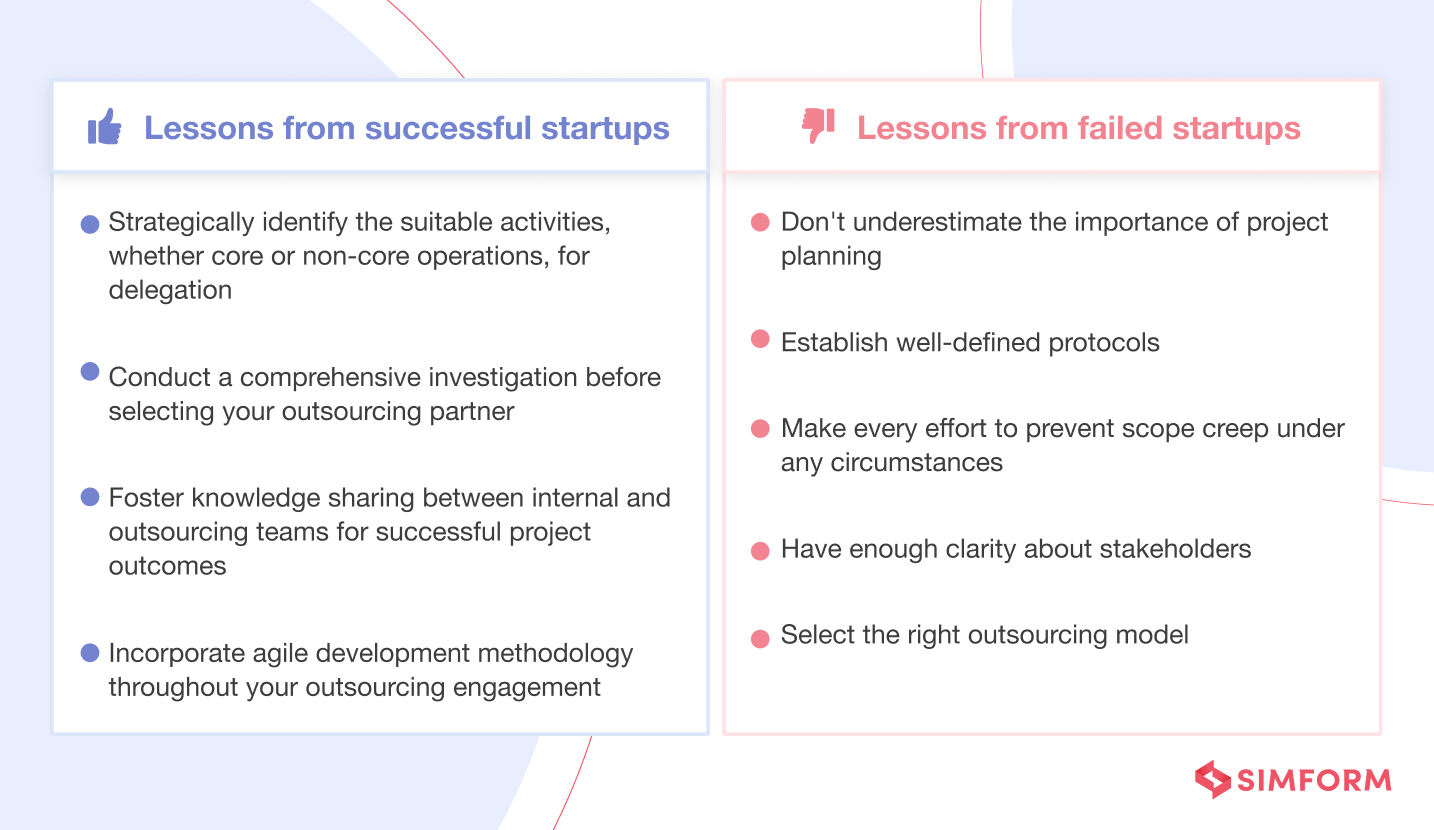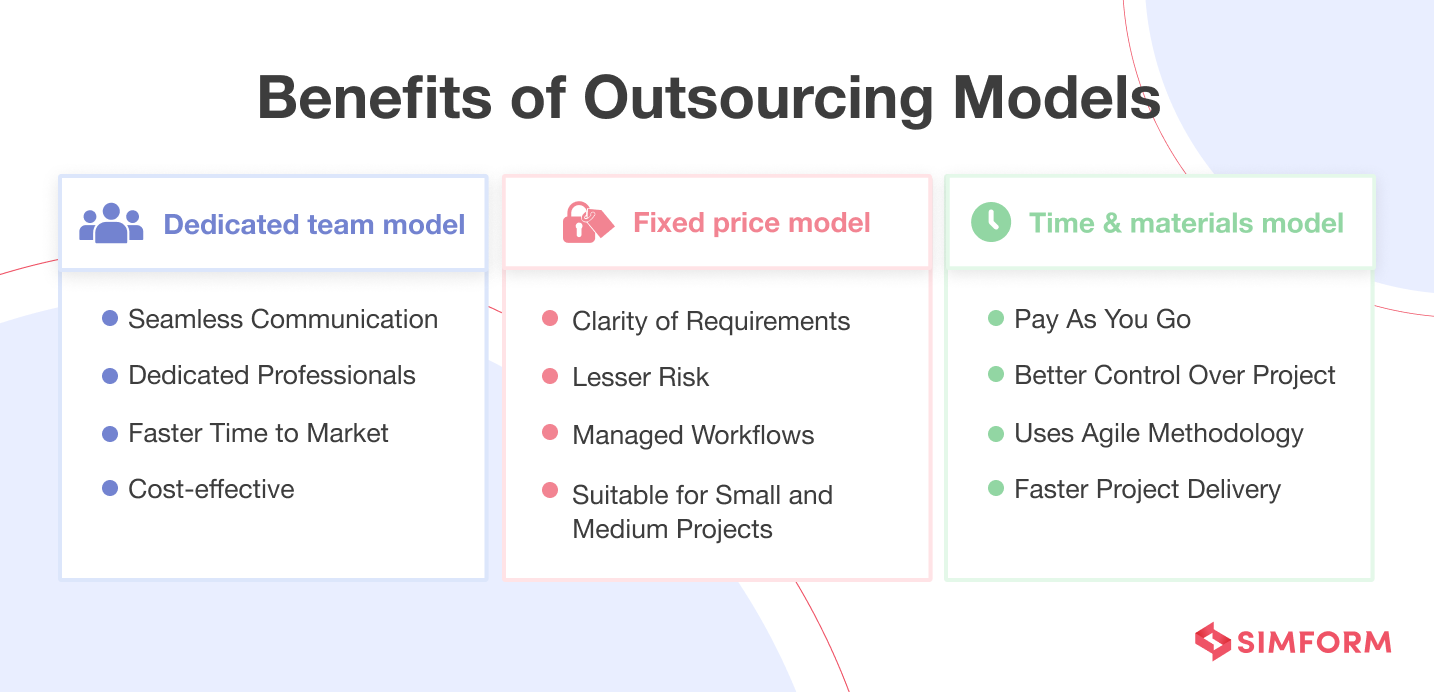Unlocking the Secrets of Outsourcing: Tales of Triumph and Tragedy from Startup Land
Imagine a small startup fueled by ambition and dreams. They outsource web development to experts, expecting efficiency, cost-effectiveness, and lightning-fast delivery. Success seems within reach.
But wait! Just when everything is going smoothly, tragedy strikes. The startup realizes it neglected to establish clear communication channels, resulting in misaligned expectations and delays. The project spirals into chaos and ultimately has to be dumped.
Outsourcing, while holding great potential, is indeed a complex endeavor that requires careful consideration and proactive measures to mitigate risks. To help your startup avoid such pitfalls, let’s delve into valuable lessons learned from both successful and unsuccessful startups when it comes to outsourcing.
These lessons serve as a guiding light to optimize the utilization of dedicated teams and maximize the return on investment. By learning from the experiences of others, businesses can navigate the outsourcing landscape with confidence, avoid common pitfalls, and build successful partnerships with outsourcing providers.

Outsourcing lessons learned from successful startups
1. Accurately identify the tasks to outsource
A fast-growing e-commerce platform experienced rapid expansion and needed to scale its operations to meet increasing customer demands. Recognizing the need for specialized expertise, they decided to outsource certain tasks to leverage external resources effectively.
After an internal assessment of their operations, they determined that customer support and backend logistics management were ideal areas for outsourcing, allowing their core team to focus on product development and marketing strategies.
As a result of their partnership with an outsourcing vendor, they observed improved customer satisfaction with enhanced customer support services, streamlined logistics management, and increased operational efficiency. This successful outsourcing approach allowed the startup’s core team to focus on strategic initiatives, driving innovation, and expanding their market reach.
Had they instead decided to outsource product development instead, they might have invested all their resources into other activities while their product struggled to deliver a satisfactory user experience.
Therefore, the first thing any startup must do while considering outsourcing is to strategically determine the right activities (whether core or non-core operations) to outsource.
2. Conduct a thorough investigation before choosing your outsourcing partner
A technology company specializing in mobile app development recognized the need to outsource their software testing and quality assurance processes. They knew they had to choose an outsourcing partner with domain expertise in mobile app testing and a proven track record of successful completion of testing projects.
To avoid the risks of partnering with an inefficient vendor, they considered factors such as the outsourcing partner’s experience in mobile app testing, their expertise with relevant technologies and platforms, the size and composition of their testing team, and their track record of successful projects.
After a thorough evaluation process that included interviews, reference checks, and reviewing case studies, they selected a reputable outsourcing company known for its expertise in mobile app testing.
As a result of this outsourcing association, they achieved faster time-to-market for their mobile apps, improved overall quality and reliability, and received positive user feedback.
This and many more such examples prove that an important success factor in outsourcing is conducting extensive research before hiring a vendor.
3. Foster a culture of knowledge sharing between internal and outsourcing teams
A technology-driven healthcare company decided to outsource their mobile app development to an external software development agency. Right from the start, they established clear and open communication channels between their internal team and the outsourcing agency.
To promote knowledge sharing, they created a shared documentation repository and knowledge base accessible to both their internal team and the outsourcing agency. This repository contained project-related documents, design guidelines, coding standards, and other resources necessary for smooth collaboration.
This collaboration and knowledge exchange between the internal team and the outsourcing agency contributed to improved problem-solving, increased efficiency, and accelerated development timelines.
The healthcare company’s successful project illustrates how a culture of knowledge sharing between internal and outsourcing teams is indispensable to achieving goals set at the beginning of the association.
4. Ensure agile development methodology in your outsourcing engagement
Identifying a lucrative market opportunity, a fintech startup wanted to build their new product quickly. So they sought the help of a software development company to shorten the time to market. The startup decided to use agile development from the beginning of their outsourcing project. They communicated this preference to the outsourcing team, and both teams agreed to work in an agile way. Agile meant they would develop the software in small, iterative steps, allowing for flexibility and continuous feedback.
To make the agile approach work, the fintech startup made sure that the outsourcing team had different types of professionals, such as developers, testers, designers, and business analysts. Teams from both sides embraced the idea of continuous improvement. They understood that requirements might change over time, so they were flexible and adaptable. They welcomed feedback from stakeholders and made adjustments to their plans and development process accordingly.
As a result, the fintech startup was able to build and launch their product faster, seizing the market opportunity that they had set eyes on. This case study reinforces the importance of going agile when it comes to software development, whether in-house or outsourced.
Outsourcing lessons learned from failed startups
1. Don’t take project planning lightly
A team of entrepreneurs had an exciting idea for banking software to optimize the loan sanction processes. However, when they opted for software outsourcing, they thought the development agency would be able to deliver the right solution because they are the experts, so they didn’t invest time in creating an exhaustive project plan.
They provided a high-level overview of their expectations to the outsourcing company but failed to communicate specific details and functional specifications. As a result, there were misunderstandings and misalignment between the startup and the outsourcing team regarding the desired features and functionalities of the banking software. Project scope, milestones, and deliverables weren’t clear. Vague timelines and informal discussions only added to the complexity.
All of this resulted in the development of a product that was very different from what the product owners had in mind. Ultimately, after so much investment into building a sub optimal banking software, the owners had to drop the idea!
This example serves as a cautionary tale of how inadequate project planning can lead to disastrous results. Here are a few tips to plan your software outsourcing project efficiently:
- Identify the problem your product aims to solve, the desired outcomes, and the value it will deliver to users or stakeholders. These elements will form the foundation of your project goals.
- Develop a comprehensive project plan that outlines the project scope, timeline, milestones, and deliverables. Define the tasks, their dependencies, and allocate resources effectively.
- Identify the necessary resources, including personnel, expertise, and infrastructure, required for the project. Consider the need for developers, designers, testers, project managers, and any specialized roles.
- Assess risks related to technology, resources, timelines, and external dependencies. Develop contingency plans to minimize disruptions and maintain project progress in the face of unforeseen challenges.
2. Establish clear communication protocols
An online casino start-up called C4 decided to outsource its software development to a talented freelancer from India. Initially, it appeared to be a great idea; however, staying in touch with the freelancer proved difficult, which resulted in conflicts and unsatisfactory results.
Consequently, this communication breakdown caused the CEO to lose trust in the freelancer, ultimately ending their business relationship. The CEO learned a valuable lesson from this experience, the importance of clear communication during software development outsourcing.
Syncing external and internal teams on progress and issues is crucial for a project’s success. And working with remote teams makes face-to-face collaboration harder, purely because some team members aren’t there in person.
To ensure effective communication in outsourcing, here are a few key points to keep in mind:
- Define preferred modes of communication, such as email, project management tools, video conferences, or instant messaging. Make sure all parties involved understand and agree upon these communication protocols.
- Designate project managers or coordinators who will serve as the primary communication links. This ensures a streamlined flow of information and provides a central contact for addressing questions, concerns, or issues.
- Establish communication escalation paths to address urgent matters or resolve conflicts effectively. Clearly define the hierarchy or process for escalating issues, such as involving higher-level management or organizing a dedicated meeting to resolve disputes or critical decisions.
- Document meeting minutes or summaries that capture key discussions, decisions, action items, and responsibilities. Share these minutes promptly with all relevant stakeholders to ensure a shared understanding and accountability.
3. Avoid scope creep at all costs
An on-demand healthcare staffing startup needed to modernize their patient management system as they needed to scale to accommodate more customers and offer advanced features. Because they already had to take care of the business side of their expansion strategy, they outsourced patient management application modernization to a small software development agency.
At the beginning of the project, the healthcare startup defined the scope of work with specific modules and functionalities for their patient management system. The outsourcing agreement was based on this agreed-upon scope. As the development progressed, the startup experienced evolving requirements due to changing regulations and market needs. However, they did not effectively manage these changes and communicated them to the outsourcing company ad hoc, resulting in scope creep.
Unsurprisingly, the new patient management system developed by the outsourcing company did not meet the startup’s expectations. The delays, budget overruns, and compromised quality hindered the project’s success and ultimately led to its failure.
Here are a few tips to avoid scope creep while working with an outsourcing partner:
- Define a formal change management process to evaluate and prioritize new requests or modifications. Assess the impact of each change on project timelines, resources, and budget before asking your outsourcing partner to incorporate them into the scope.
- Establish clear communication channels between your in-house and outsourcing teams to facilitate effective communication. Ensure all stakeholders have a designated point of contact for discussing project scope and requirements.
- Break the project into smaller, manageable Increments with clearly defined goals and deliverables. Regularly reassess and reprioritize tasks based on evolving requirements and feedback.
4. Ensure clarity regarding stakeholders
One of the major pitfalls of outsourcing can be a lack of project ownership. If your outsourcing partner hires programmers on a contract basis, project ownership becomes ambiguous.
In such a scenario, there is back-and-forth in resource allocation, which might lead to inconsistent deliverables because no project leader or constant team is accountable for the work and present throughout the entire process.
When outsourcing software development, ensure designated project managers are accountable and involved in communication channels for regular check-ins. Another significant stakeholder can be a business analyst. This individual can serve as a liaison between you and the developers, documenting functional specifications and breaking down needs for the developers.
Finding a company willing to be a potential shareholders in your project and dedicated to finding long-term solutions is crucial for successful outsourcing.
5. Choose the right outsourcing model while hiring a development partner
Selecting the wrong outsourcing model can lead to challenges such as inefficient resource allocation, lack of expertise, communication issues, limited flexibility, cost overruns, and operational misalignment.
To mitigate these impacts, startups must select an outsourcing model that aligns with their requirements and organizational needs. Several engagement models are available, including managed projects, remote developers, dedicated teams, and fixed-price models.
However, based on industry standards, you can collaborate with other companies using three main outsourcing models:

Dedicated team model
In the dedicated team model, a business can access specialized teams that operate just for them and are committed to their technology arena. Consider the dedicated team model if you want a team of skilled professionals solely focused on your project. It offers high customization, flexibility, and direct control over your outsourced team.
Fixed price model
In the fixed price model, a predetermined budget is provided to the team before collaborating with a software outsourcing provider. They work within the budget, scope, and duration parameters to reach the project goals.
If you have a well-defined project scope and budget limitations, the fixed price model may be suitable. It offers cost predictability, enabling effective financial planning and management. However, ensure your project requirements are well-documented to avoid misunderstandings.
Time and materials model
In the time and materials model, outsourcing partners charge based on a specific amount determined hourly or monthly, considering the materials used and the time invested.
If your startup has evolving requirements and a need for flexibility, the time and materials model can be a good fit. It offers greater adaptability to changing project needs and allows you to pay based on available resources.
Experienced, reliable dedicated teams are the key to outsourcing success
Accurately identifying the tasks to outsource, conducting thorough investigations to choose the right outsourcing partner, fostering a culture of knowledge sharing, and implementing agile development methodologies have proven to be key factors for outsourcing success. These lessons emphasize the importance of strategic decision-making, effective communication, and adaptability in maximizing the benefits of outsourcing while minimizing risks.
On the other hand, neglecting project planning, insufficient communication protocols, scope creep, lack of stakeholder clarity, and choosing the wrong outsourcing model can lead to disastrous outcomes.
Partnering with an outsourcing partner with a proven track record of successful project deliveries in your industry is an influential factor in the success of your startup. At Simform, we have experienced, versatile dedicated development teams working with a range of technologies. With our stringent screening processes, we ensure you have access to only the best, carefully-vetted talent for your ambitious projects.
Contact us today to discuss your requirements with our technology consultants.




